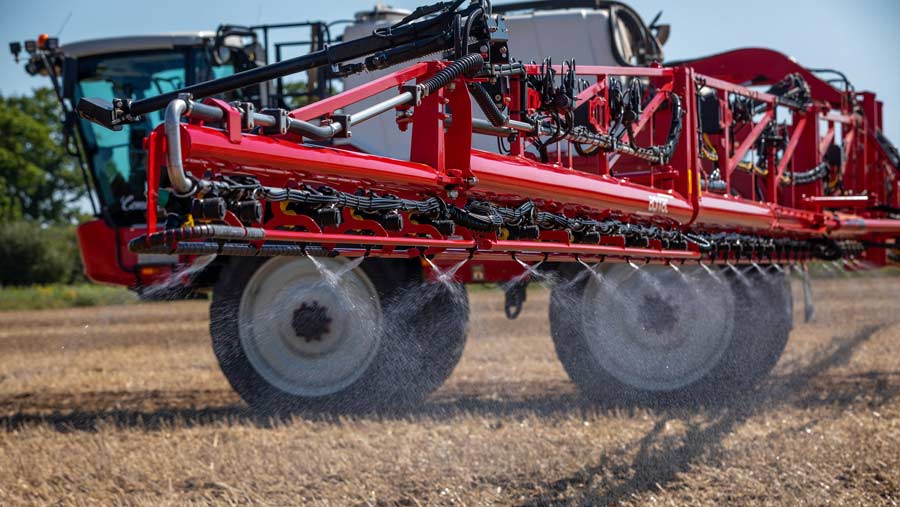Low-drift nozzles key to pre-em herbicide spray drift
 © Syngenta
© Syngenta Low-drift nozzles could help growers get more from their pre-emergence herbicide applications, with the potential for persistent and gusty winds disrupting spraying operations in the coming weeks.
With the climate becoming increasing unsettled, the frequency of category four and five storms are predicted to more than double across the globe over late summer and autumn as oceans create more vertical wind shear, which raises the incidence of Atlantic hurricanes.
For the UK, this means that catching just the tail end of a hurricane will be sufficient to bring stronger and more gusty winds that will disrupt spray application and consistent coverage.
See also: Round-up of 9 arable apps that can benefit farmers
DRT nozzles are key
A growing body of evidence from trial results at the agrochemical firm Syngenta’s Blackgrass Innovation Centre in Cambridgeshire has shown a 10% improvement in grassweed control from pre-emergence application within a few days of drilling, compared with peri-application soon after the crop has appeared.
Any delay in application due to wind could, therefore, see performance drop by a few percentage points a day.
Syngenta application specialist Harry Fordham highlights that even on days with an average wind speed of 6.5km/h (4mph), seen as an optimum spray application, there are frequent gusts that exceed that level.
Weather records from the Innovation Centre last autumn show that on 47 of 122 days investigated, the average wind speed recorded at boom height, was above 7.2km/h (4.5mph), with no days without gusts of over 7.2km/h.
This highlights the challenge for operators and the need for drift mitigation measures, which can significantly reduce the risk of spray loss.
Independent trial results have confirmed that, at any given wind speed, new drift reduction technology (DRT) nozzle designs can successfully achieve 90% less drift when compared to conventional flat fan nozzles.

Syngenta’s Harry Fordham © Syngenta
“It is particularly noticeable that in gusty conditions that disrupt the spray pattern with conventional nozzles, the 90% DRT nozzles maintain far more even distribution of droplets across the surface,” says Mr Fordham.
This is why, he advocates that all sprayers should be kitted up for pre-emergence application with the 90% DRT nozzles as standard, in order to cope with the frequency of variable conditions, with a second set of 3D nozzles fitted, if possible, for use if spraying conditions are perfect.
Mr Fordham highlights that the art of application for pre-emergence herbicides is effectively the same with both of these nozzles, with results from more than 400 trials having shown applications at 200 litres/ha give more reliable grassweed control.
He also recommends spraying at a speed of less than 12kph (7.5mph) as this greatly reduces the risk of drift created by sprayer movement, as well as making it easier for the operator to maintain a critical boom height of 50cm.
Further application trials will continue at the company’s grass weed Innovation Centre this season, where a new 3D90 nozzle, specifically designed as a first to optimise spray coverage from an angled nozzle incorporating DRT, is being investigated.
New app to aid spraying accuracy
The new Syngenta Spray Assist App is now available to help sprayer operators select the most appropriate spray techniques in order to make more accurate applications and mitigate risks.
Users have access to live local weather data to analyse the factors which influence potential risk of spray drift, including wind, rain or frost, along with a nozzle selector to suggest the optimum choices to cope with conditions.
“Selecting the appropriate 90% drift reduction technology angled nozzle design and size to deliver the desired output from operation at 2.0-2.5bar, can deliver consistently better results,” explains Harry Fordham, Syngenta application specialist.
Trials by the firm have shown a 60% improvement in herbicide results from following the Low, Slow, Covered best-practice guidelines, compared with historic farm practice.

